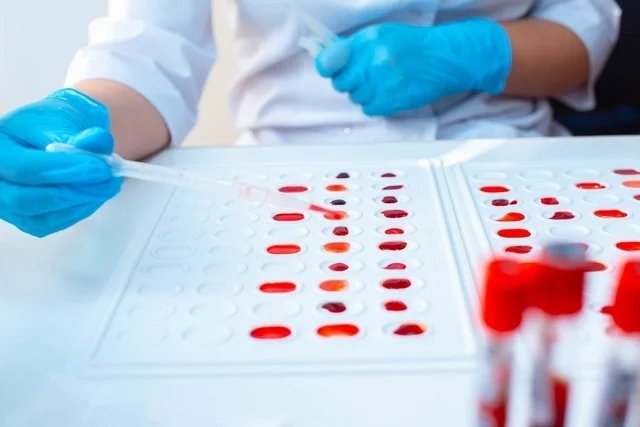Blood types are classified according to the presence or absence of antigens and antibodies present on the surface of red blood cells.
According to the ABO blood classification system, blood can be classified into A, B, AB and O. Blood type can be further classified according to the presence or absence of the Rh factor, which can be positive or negative.
People with Type O blood can donate to any person, but they can only receive this blood type. On the other hand, people with Type AB blood can receive blood from any person, but can only donate to people with the same type. It is imperative that a transfusion is only completed when blood is compatible, as non-compatible blood can result in life-threatening complications.

Types of blood
Blood can be classified into the following types:
- Type A is one of the most common types and contains B antibodies, therefore people with this type can only receive blood that is Type A or O
- Type B is one of the rarest types and contains A antibodies, therefore people with this type can only receive blood that is Type B or O
- Type AB is one of the rarest types and does not contain any antibodies, which means people with this type can receive blood that is any type without having a reaction
- Type O is known as the universal donor and is one of the most common types. It contains both A and B antibodies, and therefore people with this type can only receive blood that is Type O, or else agglutination of the blood cells may occur.
You blood type can be identified through lab tests, completed with a small blood speciman.
Rhesus (Rh) factor
Blood types are classified by the ABO system, and additionally classified as positive or negative for presence of Rhesus factor, or Rh. Rh is a protein that is found on blood cells that should also be taken into consideration when completing a transfusion. Not being aware of the blood's Rh factor can lead to serious transfusion complications.
Blood that contains the Rh factor is classified as Rh + and these people can receive blood that is both Rh + and Rh -. They can only donate, however, to Rh + people. On the other hand, blood that does not contain Rh factor is Rh -. These people can donate blood to both Rh + and Rh - people, but can only receive Rh - blood.
Compatibility chart for blood donation
The following chart shows which blood types you can donate and receive from:
What blood type will my child have?
Normally, the child's blood type is identified soon after birth, with a heel capillary test. Blood types in children can also be determined during routine bloodwork or during diagnostic testing.
It is possible to know a child’s possible blood types by knowing the parents’ blood types. Learn about the possible blood types a child can have:
During pregnancy, a mother who is Rh negative with an Rh positive baby can produce antibodies that eliminate the baby, resulting in a miscarriage. Therefore, mothers who are Rh negative should consult with their OBGYN to determine when to take the anti-D immunoglobulin. With a first pregnancy, there typically aren’t any serious problems.
Who can donate blood
Blood donation typically takes about 30 minutes. There are some requirements for donors, such as:
- Must be between the ages of 18 and 65, although people over the age of 16 can donate with parent or guardian authorization
- Must weigh over 50kg (110lb)
- Cannot have had a tattoo done in the prior 6 to 12 months, as there is a risk for contamination of hepatitis
- Cannot use illegal injected drugs
- Must wait at least 1 year after treatment of an STI
Men can donate blood once every 3 months (for a maximum of 4 times per year). Women can only donate every 4 months (for a maximum of 3 times per year). Because women already lose blood on a monthly basis from menstruation, it may take longer to recover and reproduce blood cells.
Before donating, it is important to avoid intake of fatty foods 4 hours prior, but you should also avoiding fasting. Therefore, you should have a light meal before donating, and then eat a snack following (many times, the snack is offered to you after donating). After donating, ou should ensure you are adequately hydrated, and you should avoid smoking for 2 hours as well as any intense physical activities (due to high fainting risk).
How to donate blood
People who wish to donate blood should go to a blood collection center and fill out a form that asks about health status and lifestyle. The form will be assessed by a specialist, and if qualified, you will be guided to a comfortable chair or bed.
A nurse will insert a needle into a vein in your arm, where blood will flow into a collection pouch. The donation takes about half an hour. You may be able to take this time off of work without any consequences.
After your donation, a small snack is usually offered to the donor, as it is common to feel weakness and dizziness after a donation (even though the amount of blood donated is less than a half liter, and the body can still function normally with this loss).
It is safe to donate blood without catching any illness, as blood collection centers will follow national and international safety guidelines.
